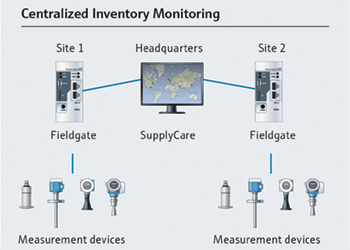
 Dr Jemili ... Rethinking enterprise technology
Dr Jemili ... Rethinking enterprise technology
Enterprise technology can play a key role in managing emissions and sustainability issues in the value chain, Dr Houssem Jemili, Partner, Bain & Company Middle East, and Uwe Schmid, Expert Partner, Bain & Company Frankfurt, tell OGN
Although the benefits of digital technology on sustainability efforts are becoming clearer to some executives, many are still unaware of the specific ways in which enterprise technology can help a company achieve its net zero ambitions—namely, by monitoring total emissions and by improving efficiency across the value chain.
But enterprise technology has always enabled companies in their business and transformations, and it has an outsized role to play in helping companies meet their carbon reduction goals in, at least, three ways:
• Enabling the transition: New applications will be critical to help companies monitor their total greenhouse gas emissions and track their progress toward meeting reduction targets.
• Accelerating the pace of change: By increasing efficiency across a company’s operations as well as its interactions with suppliers, enterprise technology can help reduce emissions across the value chain.
• Rethinking enterprise technology solutions: Finally, the enterprise technology function will need to rethink some of its basic operating principles to reduce the emissions of its own operations.
MONITOR EMISSIONS
As with any improvement programme, reducing emissions requires understanding your starting point and then measuring progress.
Without those insights, executives are flying blind, unable to identify the largest opportunities for improvement, and have little capacity to monitor progress.
Increasingly, companies have a wide variety of options from which to choose for measuring not only emissions but also for meeting environmental, social, and corporate governance (ESG) performance goals.
Software-as-a-service solutions: Many providers of risk management and ESG monitoring software are expanding their capabilities to deliver reports on carbon footprint.
The market is still young and very fragmented, so companies have a wide range to choose from, depending on their specific industry and compliance needs.
Bespoke solutions: Some companies build their own systems to track emissions and other ESG data. This is a natural outgrowth of the way that most companies start out, tracking and collating their own carbon data.
Investing in a robust, custom solution may be the right approach for companies planning to use this capability for strategic advantage.
Enterprise resource planning: Enterprise resource planning (ERP) systems, which already have extensive experience with meeting regulatory constraints in certain verticals, are upgrading to monitor and report on carbon emissions.
ERP systems already have access to the relevant resources, including data management systems. Companies can use ERP’s current capabilities as a starting point and then extend it by gathering data from a much more varied data landscape.
Distributed ledgers: Blockchain technologies offer traceability, transparency, security, speed, and efficiency—all of which could be used to track carbon emissions within an organisation and across its supply chain.
Blockchain ledgers could also be used for tracking rare metals (for example, cobalt used in batteries) or food supply chains.
Platform providers: All three major cloud service providers (Amazon Web Services, Google Cloud Platform and Microsoft Azure) are well positioned to provide advanced analytical services.
All three are developing ESG strategies based on providing cloud and analytical services and using technologies that include artificial intelligence, machine learning, the Internet of Things, and smart grid solutions, which they are piloting with key customers.
IMPROVE SUSTAINABILITY
Enterprise technology can also play an outsized role in helping to manage emissions and other sustainability issues across the organisation and beyond, up and down the value chain.
Enterprise software will also be critical in helping companies ensure sustainability throughout the value chain. Some of this will come from third-party services running on company ERP and procurement systems.
IT’S CARBON FOOTPRINT
Enterprise technology operations have a significant carbon footprint. Data centres, in particular, have come under increased scrutiny recently as the extent of their energy consumption has become more widely known.
Increasingly, enterprise technology leaders will need to include sustainability as a factor in their decision making, and they could become a model for other functions in the organisation.
ENTERPRISE TECHNOLOGY’S ROLE IN GETTING STARTED
Any chief information officer (CIO) who’s heard the statement "sustainability is the new digital" knows that they are being called upon to help lead the next big transformation while the previous one is still underway. There are many steps to take, but three important actions will help get the process started.
Play defense or offense: Every company’s sustainability journey begins with a clear understanding of the starting point and a vision of what it hopes to accomplish.
Defining sustainability strategy requires executives to decide whether they are playing defence (doing what’s necessary to meet regulatory or other compliance demands) or whether they want to play offense (investing to gain a competitive advantage).
Identify capability gaps. This is particularly important: In most cases, companies have not carefully monitored their carbon footprint, and so learning to do so is akin to developing new muscles.
Some vendors, offer ESG maturity assessments that can help companies understand where they are in the process and what they have to do to reach their goals.
Build sustainability into the organisation: IT operations have been designed with cost and speed efficiency in mind, but now architects and developers must begin to consider sustainability as well.
IT leaders will have to guide these decisions so that sustainable becomes an integral part of the design and measurement of these systems reflected in key performance indicators. The shift to a cloud-based infrastructure is one that’s ripe for rethinking.
Given all these opportunities for enterprise technology to play a significant role in reducing emissions, executive leaders of the function should feel empowered to become champions of the sustainability transformation. As technology enables more reductions and greater sustainability, that number is likely to rise.


























































































